Stock Market Fractured Extension - Getting Close to Intermediate Top
Stock-Markets / Stock Markets 2013 Apr 15, 2013 - 06:49 AM GMTBy: Andre_Gratian
 Current Position of the Market
Current Position of the Market
SPX: Very Long-term trend - The very-long-term cycles are in their down phases, and if they make their lows when expected (after this bull market is over), there will be another steep decline into late 2014. However, the severe correction of 2007-2009 may have curtailed the full downward pressure potential of the 40-yr and 120-yr cycles.
Intermediate trend - The uptrend from 1343 appears to be topping. Russell lagging.
Analysis of the short-term trend is done on a daily basis with the help of hourly charts. It is an important adjunct to the analysis of daily and weekly charts which discusses the course of longer market trends.
FRACTURED EXTENTION
Market Overview
Was it "real" buying or short-covering that drove some averages higher last week? Probably a combination of both, but it could be that the big traders saw an opportunity for a short-squeeze and took it. There was a hint that this could happen. As I mentioned in my last week's letter: "I would not be surprised to see the DOW make a new high by a few points as the SPX re-tests its high." I was wrong on both counts! The DOW exceed its high by more than a few points, and the SPX did not just re-test its high. It went significantly past to create a new all-time high.
But here is the interesting thing! The Russell 2000 and the DOW transports did not go past their recent highs. This could turn out to be significant. I have been saying all along that RUT is a lead indicator which has a good record of forecasting reversals in other indexes. It did this at the 1573 SPX top but not by a large margin, and that might have been a subtle indication that the DOW industrials, at least, was not finished. Now, however, the relative weakness of RUT is far greater than it was at the earlier top, and this should be heeded as a more important warning. Small caps and the DJ Transports led the last decline and now they are lagging the recovery. Surely this is not the way that the market starts a strong uptrend and it is more likely an indication of the "last gasp" of the trend which started at 1343. Or was it 1075? That could make a difference in the degree of weakness that can be anticipated in the next correction!
After the SPX made its low in March 2009 and started an uptrend, it emerged from a base which it had formed over the past 9 months (starting from October 2008). On the P&F chart, that base gave us an idea of how far the bull market could go. The total count has not been exhausted yet, so we can expect higher prices before we put an end to it. We are now in the general area of a "phase" count which could have been satisfied with the 1573 high, based on the structural pattern to that level. But since it has already surpassed it, SPX has apparently decided to move up to its next projection level which has already been disclosed to subscribers.
Chart Analysis
The following daily charts (courtesy of QCharts) compare the Russell 2000 index to the SPX. You can see how Russell diverged slightly from SPX just before the correction which started from the 1573 top. At that level, the relative weakness of Russell was minor, but it was enough to warn of a correction during which it gave all the appearances of having started a major decline. As a result, it increased its negative divergence with the SPX which has since made a new high by a good margin while Russell remains below its former high.
(I do not have an A/D indicator for the Russell, so I have placed under it that of the NASDAQ.) After a consolidation which was preceded by negative divergence, the two breadth indicators gave
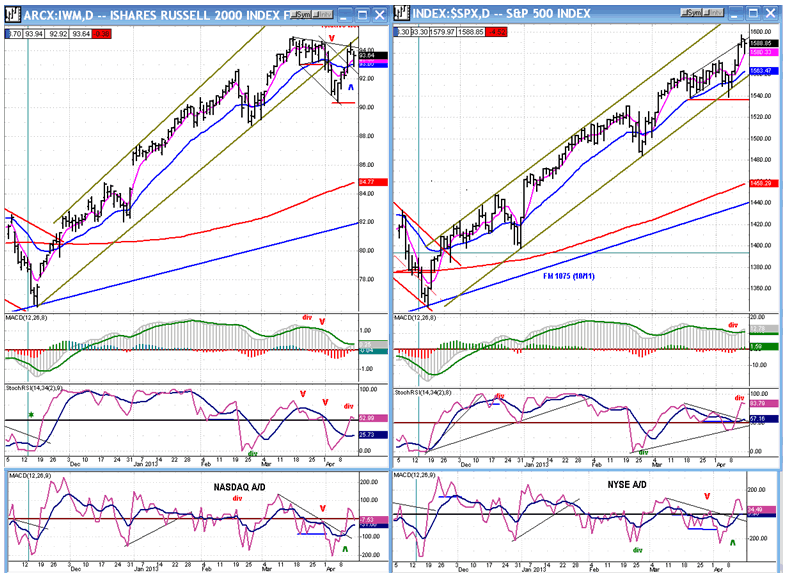
another buy signal when they broke out of their downtrend lines and rose into positive territory. This was a sign that the trend was going to be extended for a bit longer. We will now have to wait for the pattern to exhaust its current uptrend and give a sell signal.
Now, let's look at the momentum indicators, the SRSI and MACD. (The ones on the left belong to Russell, not to NASDAQ.) If you had some difficulty seeing the divergence in the price index, you will see it plainly in the momentum indicator profiles, especially in the rally from the low. The Russell MACD dropped all the way down to the zero line and has barely moved up while the SPX MACD remained at a much higher, positive level during the correction.
Both indices reached their rally high on Thursday and corrected on Friday. Although prices bounced from their morning lows, the minor correction may not be over since the session ended without a clear buy signal in the hourly indicators.
For our analysis of the hourly charts (also courtesy of QCharts) I have chosen to compare QQQ to SPX. Instead of lagging, QQQ is in sync with the latter for the first time in a quite a while. And, if anything, its indicators are even a little stronger. QQQ also remains farther away from its short-term uptrend line than SPX which is making a crawling pattern that could break the trend line at any time.
The QQQ chart gives us a good sense of the short-covering which drove the indices higher. Until 4/9, QQQ actually lagged behind SPX, but when it became obvious that the latter intended to move to a new high, the shorts in QQQ panicked and caused a price explosion. This obviously did not happen in Russell and it tells us something about the condition of that index.

The hourly indicators gave a sell signal when the decline started but came up short of giving a buy signal by the close. That could mean that more consolidation will take place on Monday.
Without question, the DOW remains the strongest index, and we need to wait until it begins to weaken noticeably before deciding that we have reached the top of this rally.
Cycles
The 7-week cycle combined with the bad jobs report to make its low a little early last Friday. If the yearly pattern of April highs continues, we should see the market make a top at some point during this month and begin a correction which should last into late June or July.
Breadth
The McClellan Oscillator and Summation Index are shown below (courtesy of StockCharts.com).
The rally has not done a great deal for the McClellan oscillator which has made it back into positive territory but only by a small margin. It has done even less for the NYSI, but since the RSI indicator of the latter had become oversold and has just started to turn, we may have to wait until it has risen to about 40 or 60% before we can look for a top in the indices.
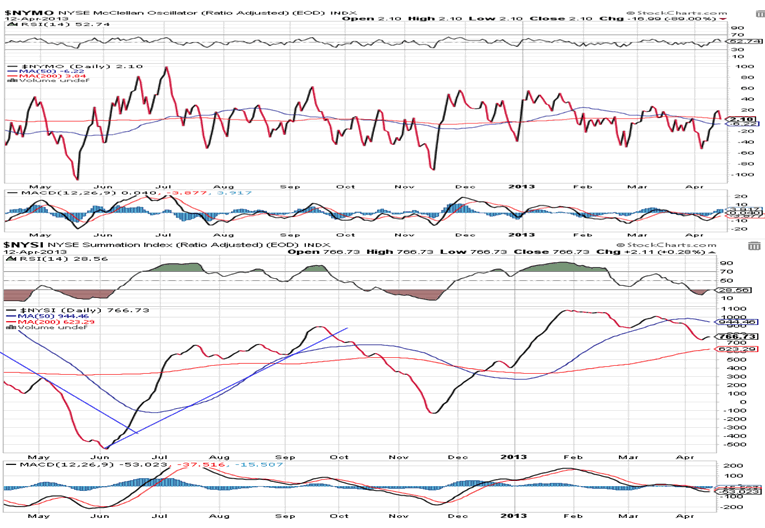
Sentiment Indicators
"If you have any doubt about how un-ready this market is to make a major top, just look at the position of the SentimenTrader (courtesy of same)".
I should have applied the same observation to the intermediate term. This amazing index is not ready to show that we have reached an important top, yet. A the new high, the long-term indicator is still just below the beginning of the light red section. It will have to do better than that before we can be on alert for a reversal.
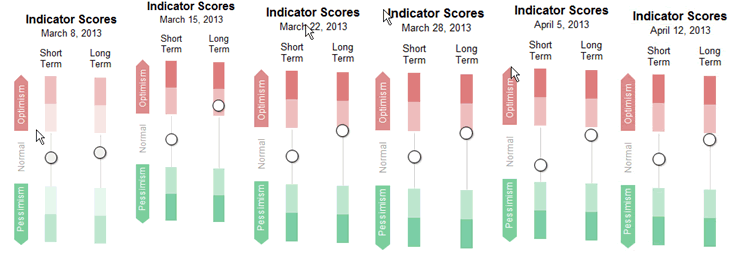
VIX
VIX made a feeble attempt at breaking out above its 200DMA, but was pushed back right away and seems to be in the process of re-testing its low. It could also very easily make a new low but, with the indicator already oversold, it may preserve its positive divergence. In any case, its current position is not predicting an imminent top in the market and, until it does, we should not expect one.

XLF (Financial SPDR)
XLF could still be close to a top but for now, it has made a new high and gotten back in sync with SPX. The P&F chart gives it another potential 40-50 cents on the upside, so let's see what it does after hitting 19+.
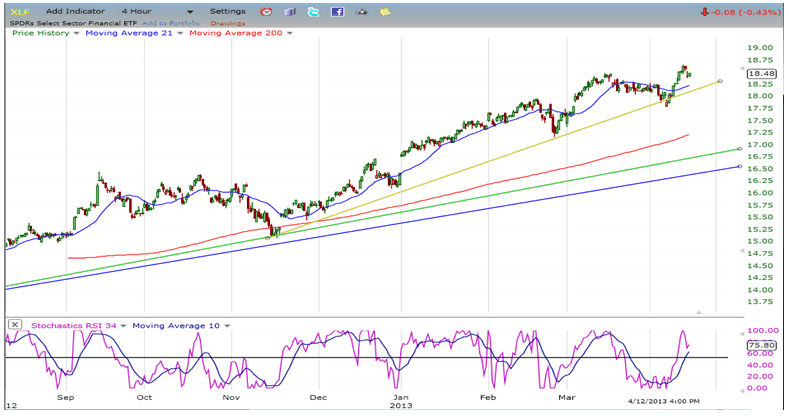
BONDS
TLT has broken out of an intermediate corrective channel and is trying to stay above the trend line and not fall back into the channel. Since it has met its initial projection to 124, it may remain in a consolidation mode for a bit longer, after which it may try for 126-127. It is not clear, what it will do after that, but it may be at the start of another good rally.

GLD (ETF for gold)
"... but let's not forget that the P&F chart gives us targets to the low 140s." That was written in last week's newsletter. I had not expected GLD to fulfill this prophecy so soon and had expected it to put up more of a fight at the 149 major support level. Now that it has filled its minimum long-term count of 143, GLD could spend some time building a base in this area, but since the two important cycles that govern its price are not going to make their lows until early May (9-wk), and early June (25-wk), it is possible that it could drop down to its secondary count of 134. This is a weaker count across the 175 top than the one to 143, but nevertheless valid and still reachable considering that the cycle lows are still several weeks ahead. This would also bring GLD close to the lower trend line of its major correction channel.
However, should GLD build a base at this level into that time period and refuse to go lower, it would be in a good position to make an attempt at resuming its long-term uptrend.
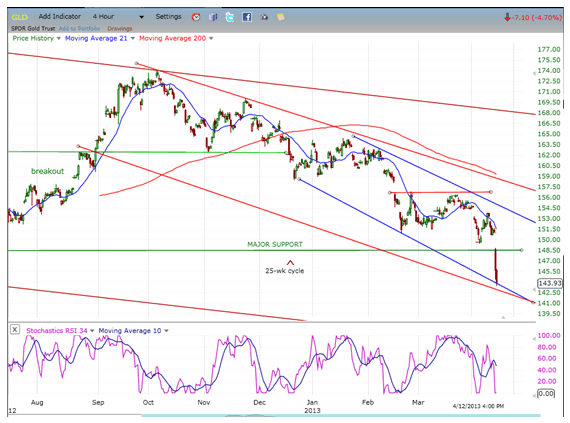
UUP (dollar ETF)
UUP is taking advantage of some renewed strength in the euro to consolidate after a good advance from the bottom of its long-term up-channel. It should find support at the peak of a last short-term high, as well as from the bottom trend line of its short-term channel. After a bried consolidation, it could be in a position to resume its uptrend toward its target of 23.40.

USO (United States Oil Fund)
USO may be in the process of confirming that its long period of consolidation was a triangle. A little more weakness in the index would validate that scenario. If so, the normal projection for this exit move would be down to the target area. Since it corresponds to a P&F projection, this gives additional credibility.
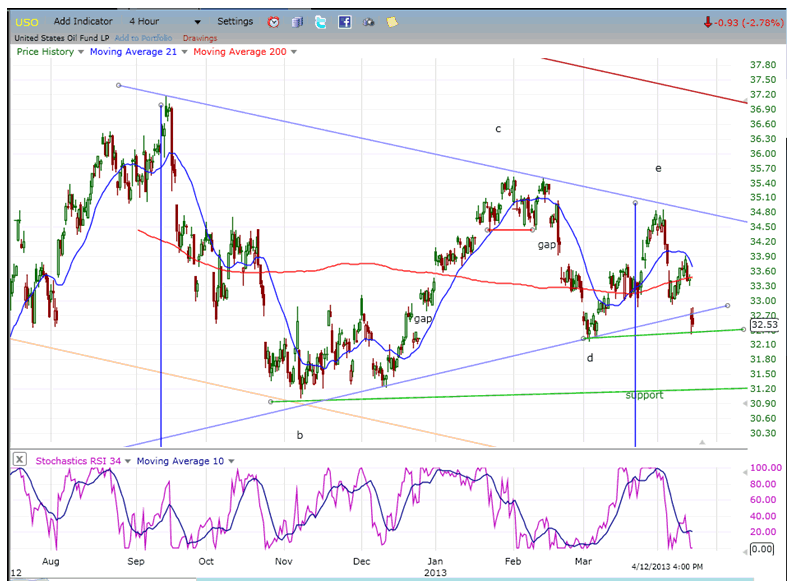
Summary
After an unusually brief consolidation, the DOW and SPX moved higher, taking the NASDAQ 100 with them. But small caps and mid-caps (best represented by Russell 2000) did not share in their exuberance and did not make new highs. Nor did the DJ transportation index. They may still participate at some later date but, by lagging behind, they are suggesting that we are getting close to an intermediate top.
FREE TRIAL SUBSCRIPTON
If precision in market timing for all time framesis something that you find important, you should
Consider taking a trial subscription to my service. It is free, and you will have four weeks to evaluate its worth. It embodies many years of research with the eventual goal of understanding as perfectly as possible how the market functions. I believe that I have achieved this goal.
For a FREE 4-week trial, Send an email to: ajg@cybertrails.com
For further subscription options, payment plans, and for important general information, I encourage
you to visit my website at www.marketurningpoints.com. It contains summaries of my background, my
investment and trading strategies, and my unique method of intra-day communication with
subscribers. I have also started an archive of former newsletters so that you can not only evaluate past performance, but also be aware of the increasing accuracy of forecasts.
Disclaimer - The above comments about the financial markets are based purely on what I consider to be sound technical analysis principles uncompromised by fundamental considerations. They represent my own opinion and are not meant to be construed as trading or investment advice, but are offered as an analytical point of view which might be of interest to those who follow stock market cycles and technical analysis.
Andre Gratian Archive |
© 2005-2022 http://www.MarketOracle.co.uk - The Market Oracle is a FREE Daily Financial Markets Analysis & Forecasting online publication.



